THE TOUCAN INTERVIEW
Chris Samnee: The Devil is in the Details, Part 2
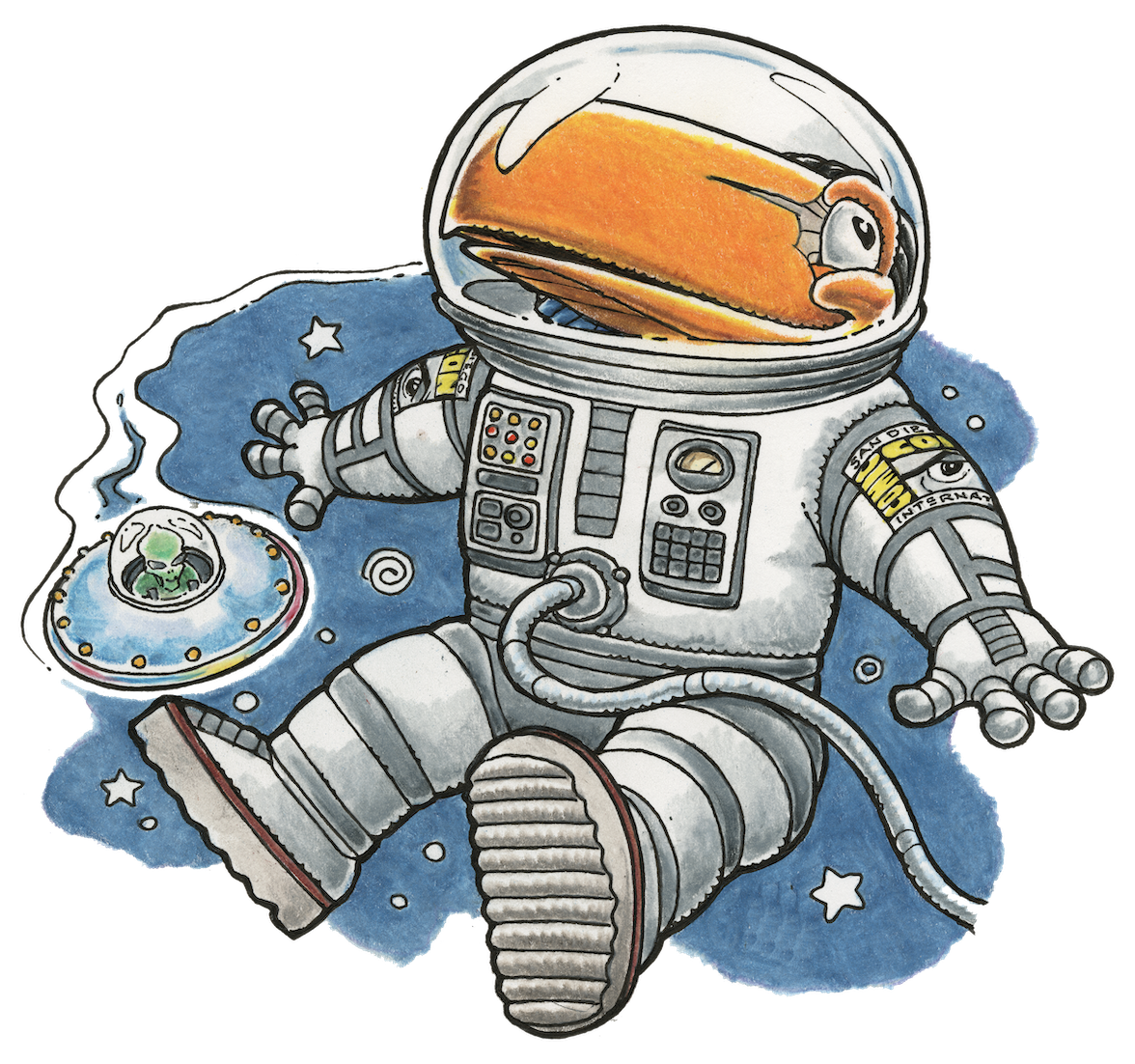
Part two of the Toucan Interview with Eisner Award-nominated penciler/inker Chris Samnee features the artist discussing his work on Marvel’s Daredevil with writer Mark Waid, and his first foray into digital comics on DC’s The Adventures of Superman, written by Jeff Parker. Click here to read Part 1! As always, click on the images to make them bigger on your screen and view them in slide show mode.
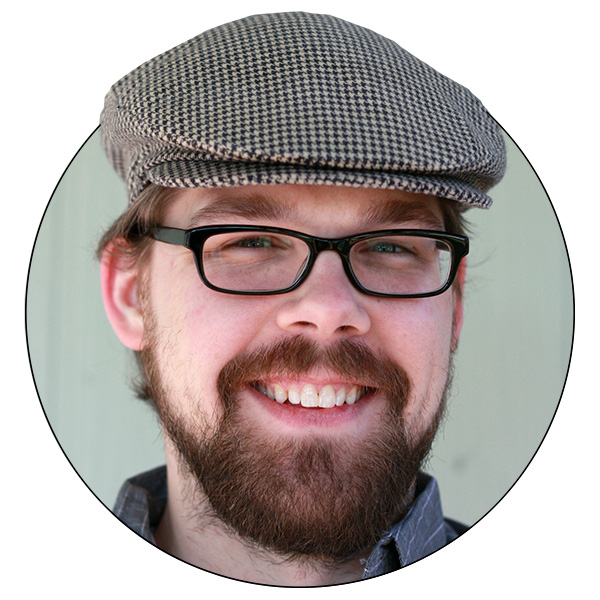
Toucan: Looking at the latest issue, the coloring in Daredevil is really, really striking. You mentioned Javier Rodriguez is going to be doing his own two-issue arc penciling and inking and coloring. Do you have any input into the color?
Chris: Not especially. I mean Javier, he’s just a genius at it. When I first started on the book, I was just a fill-in guy for issue #12 and then I quickly moved up the ranks to rotating regular artist, so I was going to be bouncing back and forth with Paolo Rivera. And for those issues Javier was still coloring the same way that he would color with Paolo. So it’s a muted pallet, soft rendered edges, very smooth, like there wasn’t any cup shadows. It was just a very soft-focus sort of look. And as of #16 when I became the regular artist, that’s when Paolo decided to leave to do his creator-owned stuff and covers and what not. I asked if we could switch things up a little bit and maybe change the coloring on the book to make it look more like what I had in my mind’s eye when I was drawing it. And Javier was up for it and [editor Steve] Wacker was up for it. Up until that point we were going for artistic consistency, which I totally get and didn’t want it to be too jarring for the reader when they read one issue and then a whole other art team is doing something else. But as the regular artist on the book, I thought maybe we could try for a little bit of a change and then we could stick with that going forward.
Toucan: It’s very vivid.
Chris: It really is, and I think that’s sort of what’s great about it . . . we can get really dark. Some of the stuff that Mark’s put in the script has gotten really dark. The coyote arc is a horror movie, but Javier’s colors make it so bright, so vivid, so pop art, it is almost camp—it was like 30 heads in a closet just sitting in there eating little bits of food, and it’s terrifying. But the way he colored it made it so it wasn’t so shocking. I mean, it was shocking, of course, that was the intent, but he didn’t muddy it up. There wasn’t blood splatter on it, it wasn’t rendered so that it felt too real. It was very flat, with just a little bit of a cut shadow and less muted colors, a bit more vivid, and it made it seem like a comic book. Comic books should be an escape from reality and I think Javier creates his own sort of reality inside the comic; I just love it. I’m blown away every time I get a new batch of pages.
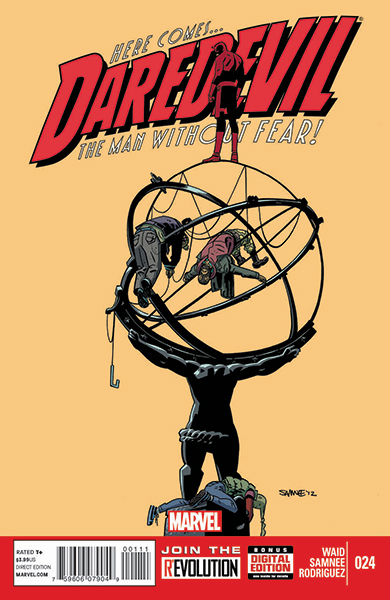
Toucan: Let’s talk about your covers for Daredevil because, and this is meant as a compliment, your covers are kind of deceptively simple but they’re also incredibly powerful at the same time. Do you have a certain philosophy behind cover design?
Chris: Not really. Paolo and Marcos Martin had done so many amazing covers before I hopped on that I just wanted to try and live up to what they had done in the 20 issues before I started doing mine. All of theirs were very simple but really beautifully designed, and there’s not a whole lot of time to get covers done. So most of my covers have been deceptively simple just so that they can get done and get across what they need to get across. Hopefully, they make people want to pick up the book. My number one goal is that a cover makes somebody want to see what’s going on inside.
Toucan: What’s the process of designing a cover? Does Mark have input into what should be going on on the cover? Obviously you work with Steve Wacker as the editor?
Chris: Well most of the time I ask what’s going to happen in the next issue, Mark writes back an email where he laughs and says he has no idea and we sort of go back and forth. Maybe Wacker has an idea of a villain or, with the cover that had Daredevil on top of the Atlas statue, Wacker suggested maybe some sort of New York landmark.
Toucan: It’s in Rockefeller Center, on the Fifth Avenue side.
Chris: Yeah and it’s right across the street from a church as well.
Toucan: St. Patrick’s Cathedral.
Chris: So I don’t know if a reader knows that ahead of time, there’s a bit of context, but if not, it’s still kind of a neat image. At the time Matt Murdock has sort of had the world on his shoulders. I liked the symbolism of him being on top of it for once. So I mean I try to get a little bit of symbolism in there without trying to be artsy-fartsy, but most of the time I just try and think of who he’s going to be fighting in that issue or maybe what the root feeling of an issue is and just try and go for it. I did a cover for Avenging Spider-Man that Wacker just said that something heartfelt is going to be happening between Peter and Aunt May, so I came up with a little scene of them sitting at the breakfast table. I have no idea how that one got approved.
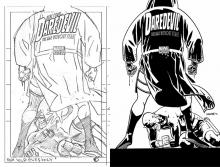
Toucan: Do you do thumbnails and submit those for approval?
Chris: Yeah, I usually do two or three, usually two that I think are pretty good and then sometimes I’ll stick one in there that just makes me laugh and sometimes those get approved. One of the covers for either #28 or #29 just has a little schoolyard bully with a shirt that says “I beat Daredevil,” and the arc coming up has to do with one of Matt Murdock’s schoolyard bullies and how, 20 years later, he’s back in Matt’s life. I just thought it would be a funny picture that I could send to the Daredevil team and maybe get a chuckle out of somebody, but that ended up being the cover that Wacker picked. So sometimes I accidentally come across a good idea.
Toucan: You recently did a Superman story with Jeff Parker for DC’s new Adventures of Superman book that appeared online first. We were talking a little bit earlier about comic strips and it seems to me that there’s a certain formatting to digital comics that’s almost comic strip-like. It’s almost like a half-page each time when you’re doing something like that online. Are there any particularly different challenges in preparing art for online usage first?
Chris: Well, I was still thinking of it just as a print book; the only problem is that every single 11 x 17 page has to be cut in half. So that in itself made for a few challenges. If you want a big panel 2, you have to sort of wiggle things around and try and make it fit because you only get a couple that are going to fit landscape on the iPad. So my layouts on it were a bit simpler than they would be on a regular print comic, just because every page had to be cut in half. But Jeff made it so there are a lot of big money shots of Superman. Each one of those is a half splash, and a half splash on the iPad screen was just one big image of Superman. I don’t think there was anything more then five panels, but there wasn’t really a whole lot of comic-stripping that came into it. I was just trying to do regular comics; I just have one odd little thing in it where I had to cut them all in half.
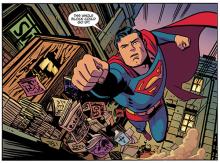
Toucan: Did you enjoy working on Superman?
Chris: Oh yeah, Superman and Batman have been my favorites since I was a little bitty kid. Getting to draw the old costume, and nothing against the new DC 52 costume, I know that it has it’s fans, but for me Superman will always have red trunks. It was fun to get to draw the Superman that I always had in my head and get to work with Parker again. I did X-Men vs. Agents of Atlas back in the day, that was one of my first jobs at Marvel, and Parker and I have been wanting to work on something since. We were actually studio mates at Periscope [Studios in Portland, Oregon] the last couple of years before I moved back to St. Louis, and we’re always talking about trying to do something. We tried to get a few things at DC off the ground and they never caught fire, but getting to do Superman with him was just great. I’ve been a fan of his for ages, and it was a super good time. It hurts a little that I didn’t get to draw Lois and Jimmy, but there’s always next time.
Toucan: I think a lot of people out there who are artists—or want to be artists—like to hear particulars about process and tools. Do you have favorite drawing tools?
Chris: I use 300 series two-ply Bristol from Strathmore. I don’t use blue pencils or anything fancy like that, I just have a .9 mm mechanical pencil that I got from Target. For inking I used to use a sable hair Rafael 8404 number 3, 4, and 5, but I found that at a lot of the conventions I draw a whole lot faster with brush pens, things that I could just stick in a bag or in a little pencil box and pick up and go and not have to worry about cleaning brushes or spilling ink on anybody. So I started using all the same supplies that I use when I draw sketches at a convention. As far as brush pens go, I use a Zebra, a Kuretake brush pen, but most of my work is with a Pentel color brush. It has a refillable barrel that you can squeeze and controls how much ink you have on your brush, which sort of feels the same as a dipped brush, but you never have to clean it. It’s synthetic hair, so all I have to do is put a cap back on and off I go, and I can ink at my studio, I can ink downstairs at my office, I can ink with my wife while we watch a movie, and I never have to worry about spilling or making a mess anywhere.
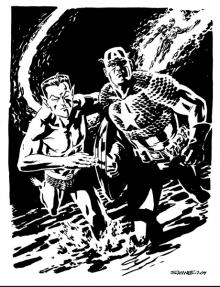
Toucan: I know you do sketches at some conventions but you don’t sell any of your original art pages. Why is that?
Chris: A few years ago it didn’t seem like it was worth it. I didn’t have a name that could make it so I could sell pages that were worth the amount of time that I put into them. I see guys selling pages on Internet sites that are art dealers for artists, and a lot of them are $30 or $40 or $50, and if you spend 12 hours on a page instead of hanging out with your family, it’s really hard to part with that for a small amount of money. That was my reasoning a few years ago. Now that I’ve gotten to the point where I could sell some of those pages for a decent amount of money, it’s made it harder to get rid of anything. I now have everything that I’ve done; it’s a full collection of every book that I’ve had in print. I hate to say it, but there’s a little bit of collector mentality. I have everything that I’ve had in print and it’s hard to break up that collection. It sounds really strange, but it’s sort of an OCD thing where I just can’t make myself get rid of it, because then all of a sudden there’s one less than there was in the collection.
Another thing is that I have a second child on the way, and comics are not the kind of thing that’s going to be around forever and I hate to say it that way. There will always be comics, but who’s to say if it’s going to be in print or digital or if I will always have a job in comics. I’ve seen a lot of guys that are amazing artists decide to pick up roots and go do animation or storyboards. This way I’ll have all of my career’s worth of comics that I can give to my kids one day and they can sell it off and have college tuition if they need it or if they get in dire straits they can hopefully make a few bucks off of it. But for the time being, I make enough money on sequential work from Marvel and DC and BOOM and Dynamite and IDW that I don’t really need to sell them to get by. If I get to a point in my career where work is starting to dry up, then I’ll gladly sell some of those pages to keep on going. But for now, I make enough that I’m okay, and if things start to get a little slow I can do a whole bunch of sketches and put them in my store and that will give us a bonus and we’re good to go for a little while longer. And I do plenty of sketches at shows. It’s not that I’m trying to keep art from anybody. If somebody wants a sketch, I’ll gladly draw a sketch at a show. It’s just, I don’t know, it’s a little hard. I don’t sell my sequential art. That makes it a whole lot easier then a big long explanation of five different reasons why I don’t sell stuff.
Toucan: Whose work do you follow now? What comics do you enjoy?
Chris: Most of the artists in comics I’ve made friends with, so I follow my friends who are amazing artists. There’s a few that I’ve never met that I’m a huge fan of, like Jordi Bernet [Torpedo, Jonah Hex], I’ll buy anything that he draws. There are a few others that are escaping me at the moment. But I also buy anything done by my friends Brent Schoonover [Hoax Hunters] or Mahmud Asrar, who does Supergirl. I buy The Activity, which is by Mitch Gerads; whenever he isn’t doing it, it’s usually filled in by Mark Laymen. Brian Hurtt and Colin Bunn, they do The Sixth Gun. They are a couple of local boys from St. Louis here as well. I’m walking over to my bookshelf. Anything Cliff Chiang does I’ll pick up. Gosh . . . James Robinson, still looking for a chance to work with him one day. We go back and forth and say yeah, we should do something one day and haven’t had a chance. Most of it is just friends, and we all sort of try and support each other as best we can—all my pals from Twitter and Instagram; Stephane Roux, I just finally met in person at a convention. I’ve been a big fan of his for years and I pick up anything that he does. Joe Quinones, Mike Allred, Jeff Parker, Paul Tobin, all my studio mates from Periscope a few years ago.
Toucan: You lived in Portland for a while?
Chris: Yeah I lived in Portland for two years. I just moved back to Missouri about six months ago. Just having a baby and having a second on the way without a support system was a bit tough. We have family here in Missouri. I was going to the studio and leaving my wife with the baby all day, and after a while I just felt bad leaving her to raise our daughter. I work pretty long hours, so to have family around is a big help.
Toucan: You mentioned James Robinson. Are there any writers you’d like to work with?
Chris: Actually I’m having such a good time with Mark Waid, that any time somebody comes near me at a convention he goes, “Get away from my artist, get away from my artist.”
Toucan: You did The Rocketeer: Cargo of Doom with him, too.
Chris: Yeah, I did it at the same time I was doing Daredevil because I got offered both around the same time and I couldn’t turn down working with Mark Waid, no matter what publisher on what book. I was like, “Oh, I don’t know if I can do The Rocketeer. Who’s writing it? Yes, I’ll do it!” And the Daredevil gig sort of snowballed into a regular job. But I didn’t tell either editor that I was working on the other one at the same time. I didn’t want them nervous that I couldn’t do two books a month. So it was a little surprise for both of them when one got announced and then the other. Before I got scripts for either, I got emails from Mark that said, “I’m a big fan, really looking forward to working with you, but what book are we doing together?” I guess I neglected to say, “Oh, yeah . . . we’re working on both.” He trusted me enough to do both, and I met all my deadlines and got two great books under my belt. I’m very proud of The Rocketeer and all the stuff that was done on Daredevil for the past year. I don’t think I’ll be doing two monthly books again any time soon; it was certainly a tough few months there, but I’m glad I did it. I don’t think if I had done both of those books at the same time that I would be nominated for an Eisner this year. I was nominated for Captain America and Bucky last year, but that was just one book. I think having two books out at the same time helps my standing.
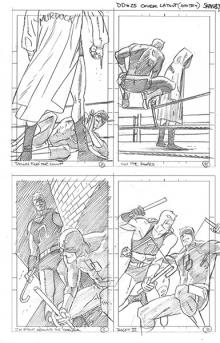
Toucan: This is the second year in a row that you’ve been nominated for Best Penciler/Inker Eisner Award.
Chris: It is, yep.
Toucan: Weren’t you a Russ Manning Promising Newcomer Award nominee a few years ago, too?
Chris: I was, yep, in 2006 for Capote. And And I won the Harvey Award for Most Promising New Talent in 2011, a couple years ago.
Toucan: In 2011, five years after the fact. That’s the way it happens sometimes.
Chris: It’s all right, I’m not going to turn it down. I still feel like people are just coming around to seeing who I am, so I’m going to be new talent to whoever is new to me. It’s an award named after Harvey Kurtzman. I will take it if it’s the best three-foot-tall monster. I don’t care what it says on it, it’s an award, I will gladly take it.
Toucan: How does it feel to have your work recognized like that, to be nominated for these awards?
Chris: It feels really weird. I’m going to be honest. It’s strange to see my name among all these great artists and people that I’m a fan of. To be in a group of that caliber is off-putting. I certainly feel like I have a really long way to go before I could be nominated for anything. I’m not telling anybody not to vote for me, but I still feel like I’m figuring a lot of stuff out. I’m better now than I’ve been before. I feel like I’ve learned a lot in my career up to this point, but I’ve barely scratched the surface of the artist I want to be. It’s a great honor to be nominated among those folks, but it’s just I still feel like I’ve got a lot to learn.
Toucan: What kind of advice would you give to anyone who wanted to break into comics today as an artist?
Chris: Don’t do it, I don’t need the competition!
But really, the problems that I see in a lot of folks coming up is that they just want to make pretty pictures and that’s not what comics are. Comics are storytelling, comics are a medium. It’s not a splash page, it’s not a cover. It’s a different discipline. Drawing a cover is not the same as drawing interior pages, and if you just want to do a really cool image, go make movie posters. What we’re trying to do doesn’t have to be 100% polished, but what you’re trying to do is tell the story that you and your writer are trying to tell in a sequential way that will absorb the reader. I think the biggest thing that I can tell people coming up is tell the story and scrap your ego, that’s the biggest thing. I have zero ego, so I may not be the best person to talk to you about it. I know that you should probably have a little bit in order to be willing to go out and beg for work and be turned down time and time again; it’s maybe a little bit of ego, a lot of drive. You have to know that this is what you want to do and you have to push yourself to do it. It’s a lot of long hours, it’s a lot of hard work. I know that it’s fun and it’s what I always wanted to do when I was a kid, but it’s hard work and you have to be prepared for it. Get your ego out of the way, tell the story as best you can, don’t worry about if it’s polished or not, and meet your deadlines—get your book done on time, that’s a big one too. Keep your editor happy.
Toucan: Are you looking forward to being a special guest at Comic-Con this year?
Chris: Absolutely. I’ve been going to San Diego since 2000. I missed a few in between because of work commitments or family, but I’ve always been a fan of the San Diego show. I’m really looking forward to coming out.
Toucan: Did you get Capote in Kansas at San Diego?
Chris: I think did, I think it was San Diego. A lot of the conventions just sort of blur together but I think it was San Diego. I had met Brian Hurtt at a local St. Louis show. Mike Allred was supposed to come, but he ended up canceling at the last minute and I didn’t know that he had canceled, so I went to the show regardless with a portfolio under my arm. Brian had his own table and Cullen Bunn was sitting with him, and this was while Brian was working on a book called Hard Time for DC, written by Steve Gerber. Rick Burchett was there, but I had met Rick several times in the past and thought, no, I’ll leave him alone, I don’t want to bother him. My wife said, you should go talk to that other guy that has art on his table. I was like, no, I don’t know, I don’t want to bother him. I’ve wanted to show my portfolio to Allred. She’s like no, we’re here, go show it to him. So I went over and I showed Brian my portfolio and he said, “This is really good, this is professional level, you should work with my friend Cullen here. And I got Cullen’s email and phone number and a couple days later we met for drinks at a Mexican restaurant and we’re like best pals from that day on. It was just, it was like elementary school. It was you like comics, I like comics, we’re best friends, and I’ve been pals with those guys ever since. And I was at the San Diego show and Brian was kind enough to say, “Hey, come over to Oni’s booth, they’re full up on portfolio reviews but this is my friend you should look at his stuff,” and they looked at my stuff and they said this is superheroes, we don’t know what we would do with this. But we have a script for a new book that we’re thinking about doing, if you wouldn’t mind doing a sample of the first five or six pages of this, we’ll take a look at it. And that was Capote in Kansas. So I did the first five or six pages and I got the gig from that. Those first pages are actually printed in the book, those sample pages are the first pages of the book. It was at San Diego that the ball started rolling, but a few weeks later is when I officially got the job.
Toucan: So you’re kind of coming home then.
Chris: Yeah . . . looks like it!